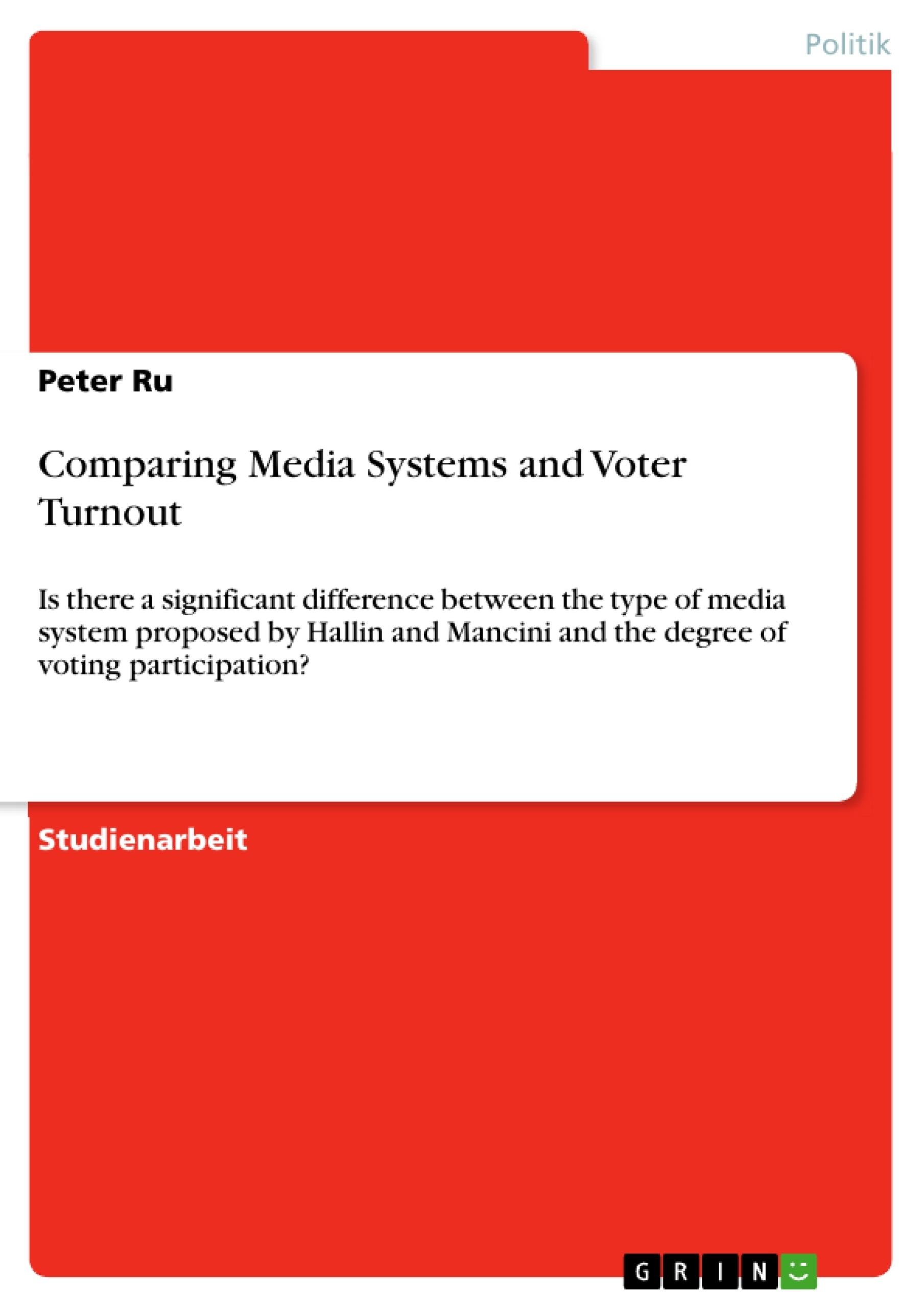
Comparing Media Systems and Voter Turnout
Hausarbeit, 2014
26 Seiten, Note: 1,0
Leseprobe
Inhaltsverzeichnis (Table of Contents)
- 1. INTRODUCTION
- 1.1. Democracy and Turnout
- 1.2. Research Question
- 1.3. Structure
- 2. LITERATURE REVIEW - Hallin and Mancini: "Comparing Media Systems: Three models of media and politics"
- 2.1. The four dimensions of media systems
- 2.2. The five political dimensions
- 2.3. The three Models
- 2.4. Reception
- 3. THEORY AND HYPOTHESIS
- 4. METHODOLOGY
- 4.1. Regression Analysis
- 4.2. Operationalisation
- 5. DATA ANAYLSIS
- 5.1. Influence of Media Markets on Turnout
- 5.2. Influence of Political Parallelism on Voter Turnout
- 5.3. Influence of Professionalization and Voter Turnout
- 5.4. Limitations
- 6. APPENDIX
Zielsetzung und Themenschwerpunkte (Objectives and Key Themes)
Diese Forschungsarbeit untersucht den Einfluss von Mediensystemen auf die Wahlbeteiligung in Europa. Sie basiert auf dem Werk von Hallin und Mancini "Comparing Media Systems: Three Models of Media and Politics" aus dem Jahr 2004. Die Arbeit zielt darauf ab, herauszufinden, ob ein signifikanter Unterschied zwischen den von Hallin und Mancini vorgeschlagenen Mediensystemen und dem Ausmaß der Wahlbeteiligung besteht.
- Die Rolle von Mediensystemen bei der Gestaltung der Wahlbeteiligung
- Die Analyse der drei Mediensystemmodelle nach Hallin und Mancini
- Die Untersuchung des Zusammenhangs zwischen den Dimensionen der Mediensysteme (z. B. Medienmärkte, politische Parallelisierung, Professionalisierung) und der Wahlbeteiligung
- Die Anwendung von Regressionsanalyse zur Überprüfung der Hypothesen
Zusammenfassung der Kapitel (Chapter Summaries)
Kapitel 1 führt das Thema der Wahlbeteiligung im Kontext von Demokratie ein und stellt die Forschungsfrage, ob es einen Zusammenhang zwischen den Mediensystemen und der Wahlbeteiligung gibt. Kapitel 2 stellt die Theorie von Hallin und Mancini vor und diskutiert die drei Modelle von Mediensystemen in Europa. Es analysiert die vier Dimensionen der Mediensysteme: Medienmärkte, politische Parallelisierung, Professionalisierung und Staatsintervention. Kapitel 3 präsentiert die Hypothese, die untersucht wird: Ob es einen signifikanten Unterschied zwischen den Mediensystemen und der Wahlbeteiligung gibt. Kapitel 4 beschreibt die Methode, die zur Beantwortung der Forschungsfrage verwendet wird, nämlich die multivariate Regressionsanalyse. Kapitel 5 präsentiert die Ergebnisse der Datenanalyse und untersucht den Einfluss der Medienmärkte, der politischen Parallelisierung und der Professionalisierung auf die Wahlbeteiligung.
Schlüsselwörter (Keywords)
Die wichtigsten Schlüsselwörter der Forschungsarbeit sind Mediensysteme, Wahlbeteiligung, Hallin und Mancini, politische Parallelisierung, Medienmärkte, Professionalisierung, multivariate Regressionsanalyse, Europa.
Details
- Titel
- Comparing Media Systems and Voter Turnout
- Untertitel
- Is there a significant difference between the type of media system proposed by Hallin and Mancini and the degree of voting participation?
- Hochschule
- Universität Mannheim (Fakultät für Sozialwissenschaften)
- Veranstaltung
- Seminar: Comparing Media Systems and Media Policies across Europe
- Note
- 1,0
- Autor
- Peter Ru (Autor:in)
- Erscheinungsjahr
- 2014
- Seiten
- 26
- Katalognummer
- V308836
- ISBN (eBook)
- 9783668125407
- ISBN (Buch)
- 9783668125414
- Dateigröße
- 990 KB
- Sprache
- Deutsch
- Schlagworte
- voter turnout wahlbeteiligung medien media system Hallin mancini voting election Bivariate regression analysis regressionsanalyse
- Produktsicherheit
- GRIN Publishing GmbH
- Preis (Ebook)
- US$ 16,99
- Preis (Book)
- US$ 18,99
- Arbeit zitieren
- Peter Ru (Autor:in), 2014, Comparing Media Systems and Voter Turnout, München, Page::Imprint:: GRINVerlagOHG, https://www.diplomarbeiten24.de/document/308836
- Autor werden
- Ihre Optionen
- Vertriebskanäle
- Premium Services
- Autorenprofil
- Textarten und Formate
- Services für Verlage, Hochschulen, Unternehmen

- © GRIN Publishing GmbH.
- Alle Inhalte urheberrechtlich geschützt. Kopieren und verbreiten untersagt.
- info@grin.com
- AGB
- Open Publishing
Der GRIN Verlag hat sich seit 1998 auf die Veröffentlichung akademischer eBooks und Bücher spezialisiert. Der GRIN Verlag steht damit als erstes Unternehmen für User Generated Quality Content. Die Verlagsseiten GRIN.com, Hausarbeiten.de und Diplomarbeiten24 bieten für Hochschullehrer, Absolventen und Studenten die ideale Plattform, wissenschaftliche Texte wie Hausarbeiten, Referate, Bachelorarbeiten, Masterarbeiten, Diplomarbeiten, Dissertationen und wissenschaftliche Aufsätze einem breiten Publikum zu präsentieren.
Kostenfreie Veröffentlichung: Hausarbeit, Bachelorarbeit, Diplomarbeit, Dissertation, Masterarbeit, Interpretation oder Referat jetzt veröffentlichen!
- GRIN Verlag GmbH
-
- Nymphenburger Str. 86
- 80636
- Munich, Deutschland
- +49 89-550559-0
- +49 89-550559-10
- info@grin.com
-









